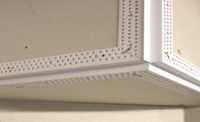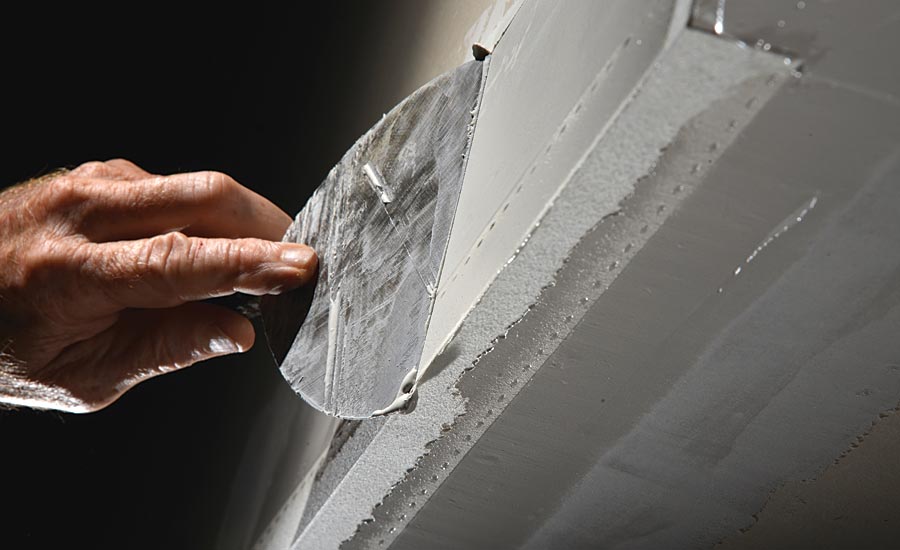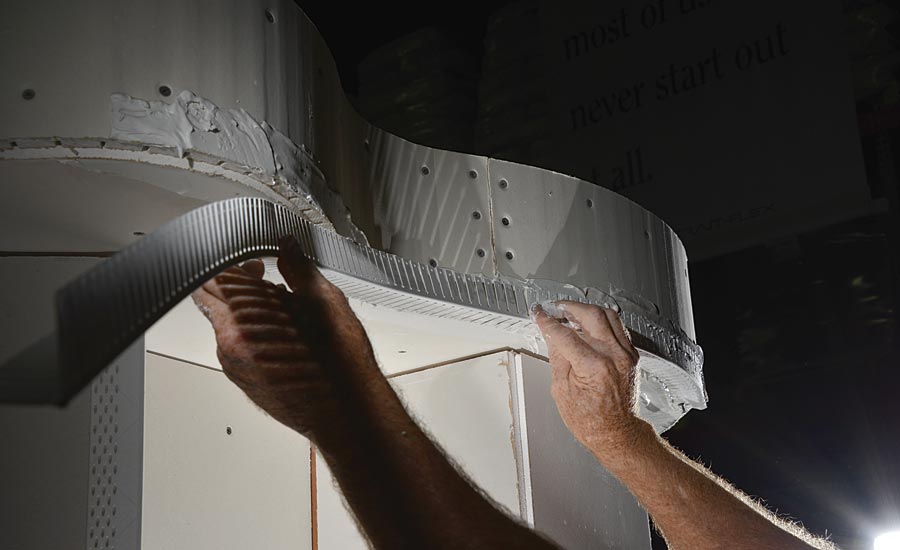Backed in a Cornerbead
Looking For That Ideal Cornerbead For Your Next Finishing Project? There Are Some Considerations And Options When Selecting One.

For contractors looking to achieve optimum productivity from their crew—regardless of skill level—composite corner bead products are quickly becoming a popular choice on the market.

Despite a growing number of alternatives, metal cornerbead remains a reliable choice. It’s strong, easy to install and makes it simple for contractors to achieve straight corners.

Galvanized metal corner bead is the most common and least expensive cornerbead material on the market, but it’s important to follow proper installation practices to ensure a good finish.

To get the most out of metal corner bead, make sure fasteners are used every 4 to 6 inches, which can minimize the risk of cracking.

Many composite corner bead products come in rolls, making them easier to transport and store, and eliminating any worry that the product could bend or warp during handling. They are ideal for high-traffic areas such as schools, hospitals or multifamily developments because they won’t dent like metal or vinyl if impacted.

Because of their slim profile, composite corner bead requires much less joint compound than traditional beads—sometimes by as much as half. The composite fiber surface embeds into joint compound and provides a superior bonding strength to gypsum board due to the flacking added to the material.

Composite corner bead is highly flexible and is a great option for finishing archways or curved walls. Also, they can be sanded to create smooth joints and won’t “fuzz up.”







For years, metal cornerbead was the industry standard and it still remains a reliable choice today. However, as contractors look for ways to be more efficient and reduce callbacks from homeowners, other material choices have rapidly increased in popularity.
With a growing number of material options, it is important for drywall contractors to become familiar with the benefits of each type of cornerbead material to ensure the best finish possible on their projects. This article will provide an overview of the options and considerations for selecting each type of cornerbead.
Metal Cornerbead: A Time-Tested Classic
The most common and least expensive cornerbead material is galvanized metal. Chances are if you’ve been in the industry a long time, metal cornerbead is your go-to option. Easily applied with either nails, screws or staples; galvanized metal cornerbead stands up well to minor wear once installed. It’s strong, easy to install and makes it simple for contractors to achieve straight corners. Despite a growing number of alternatives, metal cornerbead remains a reliable choice.
On the flip side, metal cornerbead isn’t very forgiving. If something impacts a metal corner bead, it is likely to dent and need to be replaced. It can also be susceptible to cracks along the flange edges. In addition, it is important to exercise care when handling and storing metal corner bead, as the long sticks can twist and bend during transportation and are prone to rusting if stored improperly.
To get the most out of metal cornerbead, consider using mesh tape, which can reduce the risk of cracking. Making sure nails or staples are used every 4 to 6 inches is another way to minimize some of the issues described above. Also, there are several paper-faced metal bead options on the market that provide most of the benefits contractors have come to expect from traditional metal cornerbeads, but with added strength and a more streamlined installation.
Vinyl Cornerbead: A More Versatile Solution
Unlike traditional metal beads, vinyl cornerbeads can take more abuse and still retain their form, making them a great choice for a wide variety of applications. Vinyl installs similarly when compared with metal cornerbead, so you don’t have to worry about a learning curve. It goes up with staples, nails, screws, contact adhesive or drywall mud, and crews don’t have to worry about the material twisting or bending during handling and transport.
Vinyl cornerbead is also pliable, which makes it easy to work with—especially when finishing archways or curved walls. This flexibility means it is also less likely to cause cracks in the finished wall as the building settles or as temperatures fluctuate. Plus, impacted corners are much less likely to dent, which helps eliminate homeowner callbacks.
Another benefit to using vinyl cornerbead is that it won’t rust. This makes it a great choice for bathrooms, kitchens, basements, or anywhere moisture may be present.
As with metal cornerbead, consider using a mesh tape along the edge of the flange to ensure no future cracks in the finished wall. Also, because vinyl beads are typically thicker than metal beads, you’ll have to feather the compound out further to ensure the smoothest finish.
Composite Cornerbead: A Smarter Option
Whether you are using metal or vinyl cornerbeads, there’s still quite a bit of artistry involved in achieving a finish that will look great for many years. For contractors looking to achieve optimum productivity from their crew, regardless of skill level, composite cornerbead products are quickly becoming a popular choice on the market.
Made from patented, composite material, these cornerbeads are flexible, durable, and rust-proof. Thanks to their smart construction and design, much of the finesse of corner finishing is engineered into these types of products, making them the easiest to install, in less time, without any special tools or fasteners. They cut quickly with scissors or snips and can be applied with taping or all-purpose joint compound. Because of their slim profile, composite cornerbeads require up to half as much joint compound as traditional beads. Some are even available with water-activated adhesive that eliminates the need for any joint compound, fasteners, or spray adhesives. Also, some composite cornerbead products don’t have a nose and accept paint directly, meaning installers don’t have to cover the bead all the way to the corner to achieve a great finish.
From a logistical standpoint, many composite cornerbead products come in rolls, making them easier to transport and store, and eliminating any worry that the product could bend or warp during handling.
Composite cornerbeads are available in both standard and paper-faced options. With both, the composite fiber surface embeds into joint compound and provides a superior bonding strength to gypsum board due to the flocking added to the back of the material. These products are ideal for high-traffic areas such as schools, hospitals, or multifamily developments because they resist dents and damage to a greater degree than metal or vinyl when impacted.
These products are highly flexible and can conform to irregular corners or help to span large gaps in the drywall. With more rigid cornerbeads, any irregularity in the corner creates a gap that needs to be filled with drywall compound. And unlike paper-faced metal products, composite materials won’t “fuzz up” when sanded like paper will. Thus, creating a smooth and seamless transition with less compound and less effort.
Conclusion
A finishing job is only as good as its corners, and the choice of bead material can have a major impact—not only on how productive and profitable the project is for the drywall contractor but how well the finished wall will be able to stand up to changes in the building over time. Tried-and-true options like metal still serve a valuable need in the market, but newer product technologies are certainly worth a look for those interested in greater efficiency, flexibility, and ultimately, fewer jobsite hassles with reduced callbacks
Looking for a reprint of this article?
From high-res PDFs to custom plaques, order your copy today!














